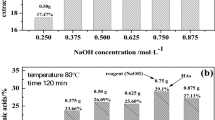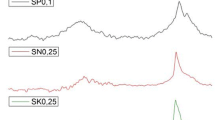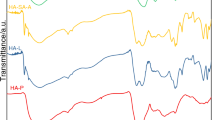Abstract
The present study investigates the efficient extraction of humic acid (HA) from Tunisian lignite (TL). The extraction method was optimized using the full factorial design (FFD) based on the interactive effects of sodium hydroxide (NaOH) and sodium pyrophosphate (Na4P2O7) concentrations, extraction temperature, and agitation time as input factors. The output response was the absorbance ratio at 465 and 665 nm (E465/E665) of HA. Fourier-transformed infrared (FT-IR), was used for the characterization of TL-HA. Under optimized conditions (NaOH of 0.8 mol l−1, Na4P2O7 of 0.06 mol l−1, a temperature of 85 °C and an agitation time of 6 h), the obtained lignite-based fertilizer contains a high HA’s aromaticity degree as evidenced by the lower ratio (E465/E665) with a value equal to 1.34. The TL-HA characterization shows the predominance of OH, COOH, CH, C=C and COO groups, which are typical functional groups in humic substances. The effects of this new humic acid (HA) source on wheat germination and root elongation were investigated. The results showed that the wheat seeds germinated in HA fertilizer diluted 20 times produced high germination percentage. Indeed, the addition, of diluted HA, increased the elongation rate of the wheat roots up to 120% compared to the controls. The results of the present study might be useful for practical and commercial applications of this fertilizer based on its humification parameters and its conformity to Tunisian legislation. To investigate the limits of this alkali exaction method, large-scale processes experiments are still necessary.





Similar content being viewed by others
References
Ali H, Akbar Y, Razaq A, Muhammad D (2014) Effect of humic acid on root elongation and percent seed germination of wheat seeds. Intl J Agric Crop Sci 7(4):196–201
Amanollah J, Asiye S (2016) Determination of humic acid by spectrophotometric analysis in the soils. Int J Adv Biotechnol Res 7:19–23
Amir S, Hafidi M, Lemee L, Merlina G, Guiresse M, Pinelli E, Revel JC, Bailly JR, Ambles A (2006) Structural characterization of humic acids, extracted from sewage sludge during composting, by thermochemolysis–gas chromatography–mass spectrometry. Process Biochem 41:410–422
Asing J, Wong NC, Lau S (2009) Optimization of extraction method and characterization of humic acid derived from coals and composts (Pengoptimuman kaedah pengekstrakan dan pencirian asid humik daripada arangbatu dan kompos). J Trop Agric Food Sci 37(2):211–223
Asma L, Shermeen T, Zafar I, Ansar M, Muhammad A, Tariq MQ, Muhammad Y, Asif N (2013) Characterization of commercial humic acid samples and their impact on growth of fungi and plants. Soil Environ 32(1):63–70
Barančíková G, Senesi N, Brunetti G (1997) Chemical and spectroscopic characterization of humic acids isolated from different Slovak soil types. Geoderma 78(3–4):251–266
Becket R (1987) Determination of molecular weight distributions of fulvic and humic acids using flow field-flow fractionation. Environ Sci Technol 2(1):289–295
Bohme M, Lue HT (1997) Influence of mineral and organic treatments in the photosphere on the growth of tomato plants. Acta Hortic 450:161–168
Chen G, Chen J, Srinivasakannan C, Peng J (2011) Application of response surface methodology for optimisation of the synthesis of synthetic rutile from Titania slag. Appl Surf Sci 258(7):3068–3073
Chowdhury ZZ, Zain SM, Khan RA, Ahmad AA, Islam MS, Arami-Niya A (2011) Application of central composite design for preparation of Kenaf fiber-based activated carbon for adsorption of manganese(II) ion. Int J Phys Sci 6(31):7191–7202. https://doi.org/10.5897/IJPS11.1510
Colombo C, Palumbo G, Sellitto VM, Cho HG, Amalfitano C, Adamo P (2015) Stability of coprecipitated natural humic acid and ferrous iron under oxidative conditions. J Geochem Explor 151:50–56
Dixit VK, Kishore N (1967) Effect of humic acid and fulvic acid fraction of soil organic matter on seed germination. Indian J Chem Sect A 1:202–206
Dridi I, Arfaoui A (2017) Organic nitrogen distribution in seven Tunisian soil types under contrasting pedogenetic conditions. Environ Earth Sci 76:205. https://doi.org/10.1007/s12665-017-6525-9
El Herradi EH, Soudi B, Naman F (2014) Valorisation des déchets ménagers par extraction des substances humiques. J Mater Environ Sci 5(5):1382–1389
Fasurová N, Pospíšilová L, Pokorný E (2008) FTIR and SFS spectra of humic acids isolated from lignite and chernozem. Chem Listy 102(15):1147–1148
Garcia D, Cegarra J, Roig A (1994) Effects of the extraction on temperature on the characterization of a humic fertilizer obtained from lignite. Bioresour Technol 47:103–106
Goupy, Creighton L (2006) Introduction aux plans d’expériences-3ème édition, Dunod
Gunjeet K, Goutam R, Hemraj H, Amit KG (2012) Optimization of protocell of silica nanoparticles using 3 factorial designs. AAPS PharmSciTech 13(1):167–173. https://doi.org/10.1208/s12249-011-9741-8
Ismail T, Ayyildiz HF, Mustafa T, Fatmanur A, Aslan T, Hussain STS, Huseyin K (2015) Chemical and spectroscopic characterization of humic acid isolated from Ilgin lignite, Turkey. Inter J Sci Technol Res 1:176–183
Khaled H, Fawy HA (2011) Effect of different levels of humic acids on the nutrient content, plant growth, and soil properties under conditions of salinity. Soil Water Res 6(1):21–29
Kim HK, Kim JG, Cho JD, Hong JW (2003) Optimization and characterization of UV-curable adhesives for optical communications by response surface methodology. Polym Test 22:899–906. https://doi.org/10.1016/S0142-9418(03)00038-2
Lubal P, Fetsch D, Siroky D, Lubalova M, Senkýr J, Havel J (2000) Potentiometric and spectroscopic study of uranyl complexation with humic acids. Talanta 51:977–991
Lukic B, Panico A, Huguenot D, Fabbricino M, Van Hullebusch ED, Esposito G (2016) Evaluation of PAH removal efficiency in an artificial soil amended with different types of organic wastes. Euro Mediterr J Environ Integr. https://doi.org/10.1007/s41207-016-0001-x
Masoumeh R, Roshanak RK, Anoushiravan MB, Ali E, Mahdi F, Samireh HN (2015) Experimental design approach to the optimization of PAHs bioremediation from artificially contaminated soil: application of variables screening development. J Environ Health Sci Eng 13:22. https://doi.org/10.1186/s402010150178y
Mona Z, Zeeshan A, Javaid A, Khurram S, Naseer S, Shahid M (2017) Extraction and characterization of humic acid from Pakistani lignite coals. Energy Sources Part A Recov Util Environm Eff. https://doi.org/10.1080/15567036.2017.1307886
Montgomery DC, Wiley J (2001) Design and analysis of engineering experiments. Wiley, New York
Naman F, Brahim Soudi B, El Herradi E (2015) Extraction and characterization of humic substances in soils of the irrigated perimeter of Doukkala in Morocco. J Mater Environ Sci 6(9):2647–2654
Niemeyer J, Chen Y, Bollag J-M (1992) Characterization of humic acids, composts, and peat by diffuse reflectance Fourier transform infrared spectroscopy. Soil Sci Soc Am J 56:135–140
Ohale PE, Uzoh CF, Onukwuli OD (2017) Optimal factor evaluation for the dissolution of alumina from Azaraegbelu clay in acid solution using RSM and ANN comparative analysis. S Afr J Chem Eng 24:43–54
Ouni Y, GhnayT Montemurro F, Abdelly C, Lakhdar A (2014) The role of humic substances in mitigating the harmful effects of soil salinity and improve plant productivity. Int J Plant Prod 8:353–374
Pettit RE (2004) Organic matter, humus, humate, humic acid, fulvic acid and humin: their importance in soil fertility and plant health. Research 1–15. http://www.humicgrowth.com/s/Texas-AM-Study.pdf
Peuravuori J, Zbankova P, Pihlaja K (2006) Aspects of structural features in lignite and lignite humic acids. Fuel Process Technol 84:23–36
Prakash P, Chitradevi A, Anand TA, Arasu R, Narendrakumar G, Masilamani Selvam M (2014) Optimization of humic acid production using RSM-CCD, its characterization and applications on Vigna mungo. Int J ChemTechRes 6(2):1531–1537
Radoslava M, van Tom M, Harro JB (2007) Changes in the sensitivity of parasitic weed seeds to germination stimulants. Seed Sci Res. https://doi.org/10.1079/ssr2004187
Richard TL, Karen HT (2009) Critical comparison of humic acid test methods. Soil Sci Plant Anal 40(15–16):2309–2322. https://doi.org/10.1080/00103620903111251
Richard TL, Daniel C, Paul RB (2014) A new standardized method for quantification of humic and fulvic acids in humic ores and commercial products. J AOAC Int 97(3):721–730
Senesi N, Miano TM, Provenzano MR, Brunetti G (1991) Characterization, differentiation, and classification of humic substances by fluorescence spectroscopy. Soil Sci 152(4):259–271
Sharif M, Khattak RA, Sarir MS (2002a) Wheat yield and nutrients accumulation as affected by humic acid and chemical fertilizers. Sarhad J Agric 18:323–329
Sharif M, Khattak RA, Sarir MS (2002b) Effect of different levels of lignitic coal derived humic acid on growth of maize plants. Commun Soil Sci Plants Anal 33:19–20
Sial MA, Dahot MU, Nisa Mangan B, Mangrio SM, Arain MA, Mazhar H (2007) Improvement of bread wheat for low water requirements through conventional and mutation breeding. Ann Agric Sci 45(2):607–619
Smidova M (1962) Effect of sodium humate on swelling and germination of plant roots. Biol Plant 4:112–118
Stevenson FJ (1994) Humus chemistry: genesis, composition, reactions. Wiley, New York
Tao J, Han GH, Zhang YB, Huang TF, Li GH, Guo YF, Yang YB (2011) Improving extraction yield of humic substances from lignite with anthraquinone in alkaline solution. J Cent South Univ Technol 18:68–72
Tiqua SM, Tam NFY, Hodgkiss IJ (1996) Effects of composting on phytotoxicity of spent pig manure sawdust litter. Environ Pollut 93:249–296
Verlinden G, Coussens T, De Vliegher A, Baert G (2010) Effect of humic substances on nutrient uptake by herbage and on production and nutritive value of herbage from sown grass pastures. Grass Forage Sci 65:133–144
Xuenyuan G, Xiaorong W, ZhimanyG Lemei D, Yijun C (2001) Effect of humic acid speciation and bioavailability to wheat of rare earth elements in soil. Chem Spec Bioavailab 13:83–88
Yang Y, Li Front H (2015) Recovering humic substances from the dewatering effluent of thermally treated sludge and its performance as an organic fertilizer. Front Env Sci Eng. https://doi.org/10.1007/s11783-015-0827-5
Zucconi F, Monaco A, Forte M, de Bertoldi M (1985) Phytotoxins during the stabilization of organic matter. In: Gasser JKR (ed) Composting of agricultural and other wastes. Applied Science Publishers, London, pp 737–785
Acknowledgement
Ahmed Wali is supported by a MOBIDOC Postdoctoral Fellowship under PASRI program (Projet d’Appui au Système de Recherche et de l’Innovation) funded by the EU and managed by the ANPR (Agence Nationale de Promotion de la Recherche Scientifique, Tunisia).
Author information
Authors and Affiliations
Corresponding author
Ethics declarations
Conflict of interest
The authors declare that there are no conflicts of interest to disclose related to this work.
Additional information
Editorial handling: Sudip Chakraborty, Chief Editor.
Rights and permissions
About this article
Cite this article
Wali, A., Ben Salah, I., Zerrouki, M. et al. A novel humic acid extraction procedure from Tunisian lignite. Euro-Mediterr J Environ Integr 4, 24 (2019). https://doi.org/10.1007/s41207-019-0115-z
Received:
Accepted:
Published:
DOI: https://doi.org/10.1007/s41207-019-0115-z




